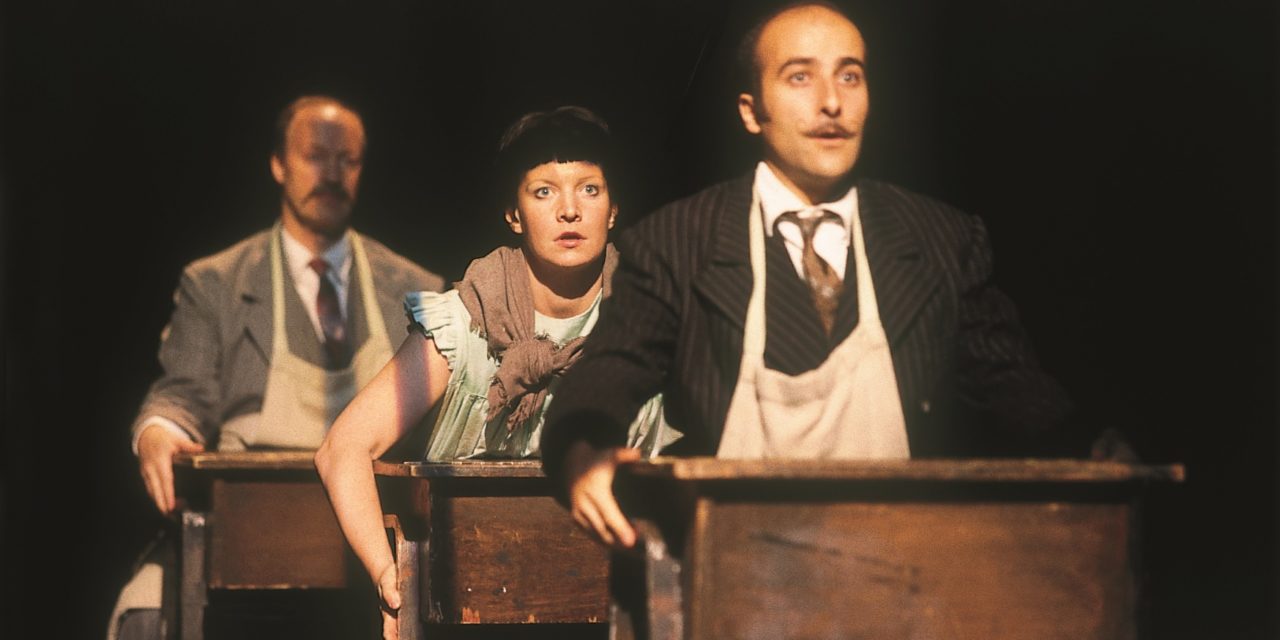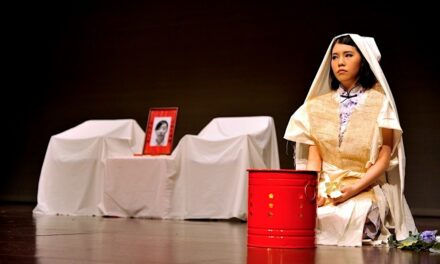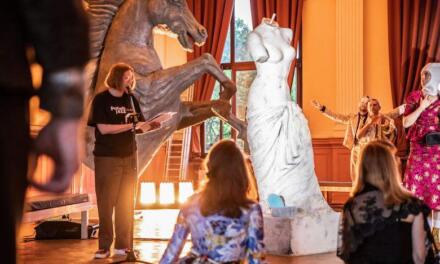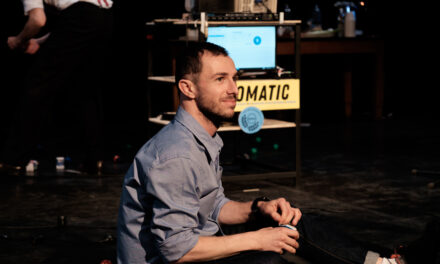Among numerous interests of dramaturgy, intense performativity of literature, on the one hand, and possible textual aspirations of a stage event, on the other, may be considered particularly stimulating. There is no danger now that literature and literary studies aspire to subordinate theatre and the whole range of theatre studies, dramaturgy included. Distinct as they are, the literary and the theatre studies are, to a certain degree, interconnected and may be mutually instructive. Literature, in its entire variety, has remained one of the major inspirations for theatre. Even when treated instrumentally, or deconstructed, literature institutes a point of (negative) reference for a theatrical event. There is, of course, a group of performances which deliberately ignore all possible allusions to the literary, the textual and the written, but this group is not of interest now.It is frequently stressed that dramaturgy, and the profession of a dramaturg, is spread between a text, or texts, and the stage. [1] Although the function of the discipline is usually seen as directed towards the stage (echoing the cliché dictum “from page to stage”), we certainly should not forget about the contrary tendency. First, theatrical work of actors and directors results, at times, in substantial changes introduced to the post-production editions of the previously published plays. Second, playwrights confront their scripts with the practicalities of stage craftsmanship in the process of writing, i.e. before publication. Finally, the playtext itself may be a textual reflection of a collective theatrical work as is the case in devised theatre. These illustrative examples give credence to the statement saying that dramaturgy – as the discipline spread between the domain of texts and that of theatre – is not a one-dimensional enterprise of adapting textual material to the requirements of theatre. It also encompasses those processes which adjust the theatrical material to the needs of the written.
It is frequently stressed that dramaturgy, and the profession of a dramaturg, is spread between a text, or texts, and the stage. [1] Although the function of the discipline is usually seen as directed towards the stage (echoing the cliché dictum “from page to stage”), we certainly should not forget about the contrary tendency. First, theatrical work of actors and directors results, at times, in substantial changes introduced to the post-production editions of the previously published plays. Second, playwrights confront their scripts with the practicalities of stage craftsmanship in the process of writing, i.e. before publication. Finally, the playtext itself may be a textual reflection of a collective theatrical work as is the case in devised theatre. These illustrative examples give credence to the statement saying that dramaturgy – as the discipline spread between the domain of texts and that of theatre – is not a one-dimensional enterprise of adapting textual material to the requirements of theatre. It also encompasses those processes which adjust the theatrical material to the needs of the written.
There is one substantial consequence of assuming such a perspective. The primacy of the mediatory role of dramaturgy reveals an ethical dimension of the discipline. By stimulating varied processes of meaning transformation, dramaturgy participates in transposing the singularity of a literary experience (i.e. reading) to the domain of theatre. Or, vice versa, it aims at “translating” the singularity of theatrical experience in the specific “language” of literary drama. Both processes are endowed with huge communicative responsibility as they put at risk intrinsic qualities of what may be best named, with the help of a term adapted from translation studies, the “source material.”
When discussing similar issues, Derek Attridge states that:
[…] a responsible response to an inventive work of art […] is one that brings it into being anew by allowing it, in a performance of its singularity for me, for my place and time, to refigure the ways in which I, and my culture, think and feel. [2]
In many ways, dramaturgy is the art of exploring singularity of a communicative act in one medium so as to transpose it to another (literature used for theatrical purposes or theatrical practice put in literary context). In this process of innovative transformation of meanings, the position of a mediator is exposed and endowed with a crucial role. The dramaturg is supposed to “responsibly respond” and “bring it anew” so as to remind the theatrical audience of their specific communicative position. (It works in a parallel way in the case of readers of drama.) The question arises how all this works in practice.
Generally speaking, when dealing with contemporary playtexts, readers tend not to bother with nuances of their linguistic materiality. Playtexts are usually seen as scripts for theatrical performances and not complete literary artifacts. Dramatic literature is highly underestimated. Yet, some of the best work of dramaturgy is still to be discovered in the domain of written drama, which is to be observed also in the case of such theatre-based companies as Complicité.
The case of Complicité
Complicité’s published plays are usually treated as textual accounts documenting certain versions of “constantly shifting and moving” [3] “compositional pieces” [4] which originated in theatre. Yet, functioning as textual adaptations of their stage predecessors, Complicité’s playtexts generate new meanings, incite original aesthetic experience, and challenge some of the implications set by performances. This is to say that even in the case of playtexts published by Complicité, we are faced with artistically independent entities. Unlike fleeting performances, playtexts are accessible at any time and in any place. They are capable of reaching those who did not have a chance to see the play in theatre. Finally, in spite of collective origins of a devised performance, playtexts based on such performances are endowed with a certain degree of textual authorization. Hence, inherent qualities of a written text provide structures which reshape semantics of a devised play. Trivial as it is, the statement that a theatre performance is one thing and a playtext another bears interesting aesthetic consequences and gives additional prominence to the work of dramaturg, the one who is – in this case – responsible for adapting theatrical conventions to the textual specificity of dramatic literature.
Such adaptation usually requires substantial changes in methods of segmentation. Unlike in theatre, the division of playtext in smaller compositional units can be achieved by neither the visual nor acoustic stage signals but only by their linguistic descriptions. This is to say that in dramatic literature even most rudimental theatrical delimitators (such as a curtain) acquire linguistic materiality (the word “curtain” is necessary to depict an image of a curtain and, thus, announce the beginning of the action). As basic elements of stage directions, words describing visual and acoustic signals become involved in relations with other linguistic signals and are subordinated to strictly literary regulations.
The playtext of The Street Of Crocodiles is Simon McBurney and Mark Wheatley’s textual adaptation of a performance “based on the stories by Bruno Schulz” [5] and devised by Complicité. Unlike in theatre, the composition of the published play reveals superimposed senses that facilitate its interpretation. The play is divided into four parts, which are embedded in a clearly biographical framework of the “Prologue” and the “Epilogue.” Intertextual context of the play is additionally defined by naming each part with a phrase originating in Bruno Schulz’s narratives: “Part One: Act of Remembrance,” “Part Two: The Age of Genius,” “Part Three: The Republic of Dreams,” and “Part Four: The Act of Destruction.” What is more, each part is further divided into episodes, which are not only named but also contain appropriate quotations from a variety of letters and Schulz’s narratives. It is worth stressing that these citations are an exclusively textual phenomenon and they were not presented during the performance. As the example of The Street Of Crocodiles illustrates, the very nature of a published play provides means for endowing its segmentation with superimposed textual meanings. This, in turn, shapes further interpretative procedures of the reader in the way which is independent of the procedures fixed by the original theatrical production. In other words, in the mediating process of adapting the devised play to a page, McBurney and Wheatley “responsibly responded” to the Complicité’s “inventive” performance and attempted to “bring it anew” in the context of dramatic literature.
In their “Note on the script,” McBurney and Wheatley underline the complexity of hermeneutic process in which The Street Of Crocodiles is involved. After all, its textual version is an adaptation of a theatrical performance based on Bruno Schulz’s narratives and biography, which means that the playtext is seen as a dramatic response to a theatrical response to a narrative work of art:
So, this book is more the record of a process than a text for performance; a map rather than a play. A play is a place which demands to be inhabited; both origin and destination, linked by a clearly determined path. A map indicates the landscape, suggests a multitude of directions, but does not dictate which one you should take. A map, however beautiful, is a guide not a site. If you wish to visit the site yourself, pick up Schulz’s books. And travel. [6]
By drawing our attention to the tertiary character of their text on the one hand and to the true artistry of the original on the other, McBurney and Wheatley not only give prominence to the singularity of an aesthetic experience (as if saying: “this is our reading of Schulz, check what’s yours”) but also complete what George Steiner calls “reiterative stage” of a hermeneutic process. They restore communicative balance. They compensate what they have taken away from the original. [7]
In this way, McBurney and Wheatley express one of the central ethical concerns of the discipline in question. As the art of mediation, dramaturgy incessantly disrupts the balance between literature and theatre and it does so in more or less radical ways. So far I have used the example of The Street Of Crocodiles in order to illustrate shifts in the semantics of segmentation in the course of authorial adaptation of a theatrical performance to the structures of dramatic literature but it is true that the reverse process is nowadays more frequently associated with the discipline of dramaturgy.
Adaptation of literary conventions and structures to the theatrical purposes may result in equal shifts in the semantics of segmentation. In Complicité’s production of Endgame by Samuel Beckett, for example, the opening and ending scenes were embedded in ambient music, which blurred the demarcation line of theatrical semiosis. By subtly contemplating the transgression of the boundaries of the performance, Complicité lay much emphasis on the framework. Given the fact that the final visual image (the light coming on Clov from the right window) was one of few added elements in this otherwise text-bound performance, the framework (hence, the segmentation) acquires significant role as a theatrical commentary – “a responsible response” – to the playtext.
A more radical transformation of compositional principles may be observed in the play based on John Berger’s long-short story and entitled The Three Lives Of Lucie Cabrol where Complicité substitutes original three parts with just two, and substantially reduces the third posthumous “life” of Lucie. Unlike in the case of Beckett’s Endgame, where the promotion of the frame underlined the company’s subtle commentary on Beckett’s play (i.e. blurring the boundaries between the fictional and the external; introducing – by the ray of light – a notion of disturbing hope to the final tableau), in The Three Lives Of Lucie Cabrol the transformation of the overall segmentation lays emphasis on the process of selection of the literary material when it is adapted to theatrical purposes. The former provides an innovative response to the original piece. The latter exposes one of the essential features of dramatology when it deals with adapting narrative texts for the stage.
The example of Complicité has illustrated that even in the case of a strictly theatre-based company, dramaturgy encompasses a range of processes that mediate between literature and theatre. As the dynamic history of the term proves, dramaturgy operates in both directions and is equally prominent when adapting literature for theatre and when theatrical conventions are transcribed for the objectives of dramatic literature. In one way or another, the role of dramaturgy exhibits an ethical dimension as the decisions undertaken by dramaturg are burdened with much hermeneutic responsibility. As elsewhere, it is not an easy task to give justice to the transformed original.
The original version of this article was published in The Routledge Companion to Dramaturgy. Reposted with permission.
[1] An extensive and multifaceted debate on these relations was presented in Notatnik Teatralny 58-59 (2010).
[2] Derek Attridge, The Singularity of Literature, (London: Routledge, 2004), 125.
[3] Complicite, Plays 1: The Street of Crocodiles, The Three Lives of Lucie Cabrol, Mnemonic, ( London: Methuen Drama, 2004), xi.
[4] Complicite, Plays 1, x.
[5] Complicite, Plays 1, 6.
[6] Complicite, Plays 1, 6.
[7] For a more detailed discussion on Steiner’s understanding of a hermeneutic process see: George Steiner, “Translation as conditio humana,” in: Übersetzung Translation Traduction, edited by Harald Kittel et al. (Berlin: Walter de Gruyter, 2007), 1-10.
This post was written by the author in their personal capacity.The opinions expressed in this article are the author’s own and do not reflect the view of The Theatre Times, their staff or collaborators.
This post was written by Tomasz Wiśniewski.
The views expressed here belong to the author and do not necessarily reflect our views and opinions.


















